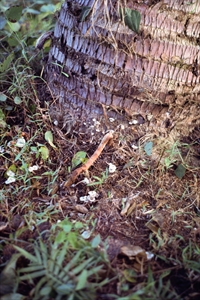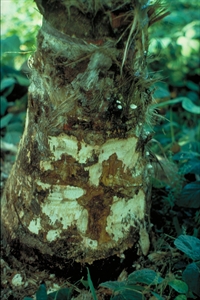Coconut basal trunk rot
Pacific Pests, Pathogens and Weeds - Online edition
Pacific Pests, Pathogens & Weeds
Coconut basal trunk rot (484)
Marasmiellus albofuscus; previously known as Marasmius albofuscus, and possibly Hemimycena longicystis.
The fungus is recorded widely: Asia (China, Indonesia), North (Hawaii, Florida) and South America (Argentina), the Caribbean (Cuba, Lesser Antilles), Oceania. The disease is recorded only from Solomon Islands.
Coconut; mostly, the fungus is a saprophyte, i.e., it lives on dead or decaying organic matter.
The fungus i
Marasmiellus albofuscus is also associated with non-germinating seednuts in coconut nurseries, and also on weeds and organic materials at the base of coconut palms. It is unknown if the fungus causes embryo rot similar to that of Marasmiellus inoderma (see Fact Sheet no. 70).
Sporophores of Marasmiellus albofuscus are small white mushrooms; caps are 4-8 mm diameter, with slightly depressed pale brown discs in the centre. Spores are oval..
A weak pathogen on trunks of coconuts and unlikely to cause structural damaged to the trunks of the palms, or affect yields. Rots in the cortex are shallow. The incidence of embryo rot of seednuts associated with Marasmiellus albofuscus is very low, much less than that caused by Marasmiellus inoderma.
Look for fruiting bodies on the basal trunks of coconuts, on grasses and legume weeds growing nearby. Look for sporophores of the fungus on seednuts in coconut nurseries where seednuts show symptoms of embryo rot. (Note, in most cases, the common fungus in those situations is Marasmiellus inoderma).
BIOSECURITY
Although it is not yet proven that Maramiellus albofuscus is parasitic on coconut palms (or any other plant), the fact that it can inhabit seednuts is of concern and warrants attention. This is not the only marasmioid or other kind of fungus that grows in seednuts. There is evidence that Marasmiellus cocophillus (see Fact Sheet no. 69), Marasmiellus inoderma (see Fact sheet no. 70), Maramius crinisequi (see Fact Sheet no. 05), and Rigidoporus zonalis, enter seednuts either before or after nutfall. Because of this, the FAO/IBPGR Technical Guidelines for the Safe Movement of Coconut Germplasm should be followed when transfers of coconuts are made between countries: (https://www.bioversityinternational.org/fileadmin/_migrated/uploads/tx_news/Coconut_361.pdf/).
CONTROL
There is no recommended treatment; from present evidence it seems unlikely that it causes a disease of economic importance.
AUTHOR Grahame Jackson
Information from Kohler F, et al. (1997) Diseases of cultivated crops in Pacific Island countries. South Pacific Commission. Pirie Printers Pty Limited, Canberra, Australia; and from Jackson GVH & Firman ID (1982) Seedborne marasmioid fungi of coconuts. Plant Pathology 31: 187-188. Dr DN Pegler, Kew Botanic Gardens, UK, is thanked for identifying specimens of Marasmiellus albofuscus from coconuts of Solomon Islands.
Produced with support from the Australian Centre for International Agricultural Research under project HORT/2016/185: Responding to emerging pest and disease threats to horticulture in the Pacific islands, implemented by the University of Queensland and the Secretariat of the Pacific Community.





